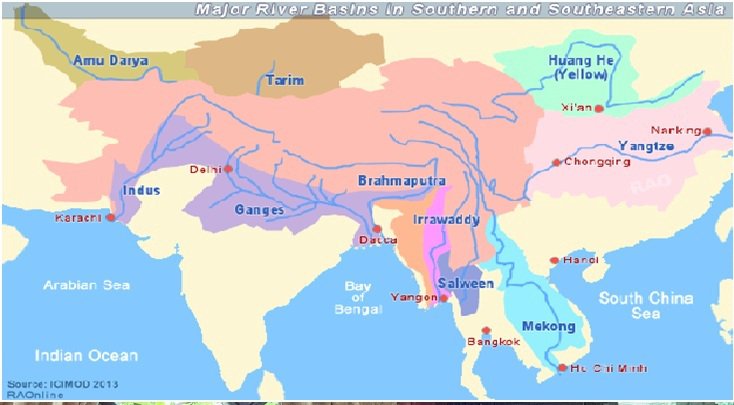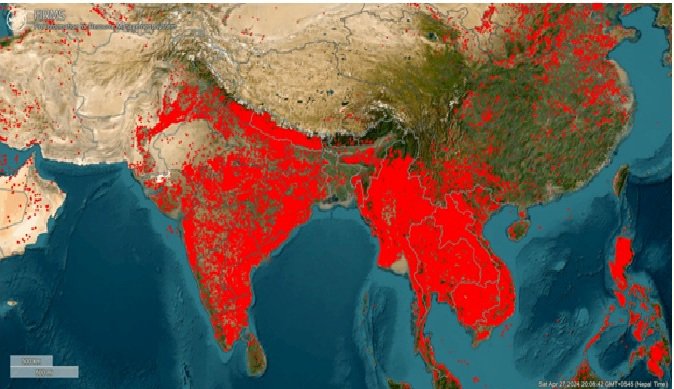
Human induced climate change has been a global challenge with far reaching consequences, impacting economies, ecosystems and communities worldwide. Blunt warnings from leading climate scientists as highlighted in The Guardian’s recent survey, paint a grim future where global temperatures are expected to exceed agreed upon limits, heralding the cascade of calamities including famines, conflicts, and mass displacements where the drivers will be extreme weather events of unprecedented intensity.
The intricate web of human induced climate change impacts in Nepal, which serves as a distressing microcosm of these challenges, and the region weaves together the alarming projections of global temperature rise, weather extremes, the surge in forest fires and the ever-escalating retreat of Himalayan glaciers.
This retreat alters the region’s hydrology and poses an imminent threat in the form of glacial lake outburst floods (GLOFs), where sudden drainage of glacial lakes can unleash a catastrophic flood downstream. Nepal, alone has over2, 700 such lakes - ticking time bombs threatening millions. These interconnected issues are a major threat to over 2 billion people in 12 countries of South and Southeast Asia, 10 major river systems, ecosystems, biodiversity and cultural heritage that are dependent on the Himalayan glaciers for their sustenance.

In parallel, the increasing frequency and intensity of forest fires in Nepal and the region add another layer of complexity to the already challenged environmental landscape. Triggered by a combination of climate change induced weather extremes, drought, erratic precipitation patterns and anthropogenic activities, these wildfires ravage ecosystems substantially decreasing the carbon sequestration, threaten biodiversity, degrade air quality and deposit black carbon on the Himalayan/Hindukush glaciers further accelerating their melting.

Available data underscores the sobering predictions that, even in the most optimistic scenarios, the Himalayan glaciers could lose up to 50% of their volume by 2100.In the worst-case scenario, the Himalayas and the Hindu Kush region could see 75-80% loss of glacier ice, with devastating consequences for the countries and communities depending on these vital resources.
Addressing this upcoming existential crisis requires a coordinated, intergovernmental effort to monitor, study, and develop strategies, policies and programs to mitigate the impacts of human-induced climate change on glacier retreats. The establishment of a laser focused International Center for Glaciers would be a crucial step in this direction.
The aim of such a center would bring leading experts, researchers, and policy-makers from the respective countries to comprehensively monitor glacier dynamics, embark on interdisciplinary research, assess vulnerabilities, devise adaptation and mitigation strategies on a trans boundary approach and advocate for evidence based policies to ensure the future of this vital region and the well-being of over 2 billion people – 1/3 of the global population who depend on its glacier-fed water resources.
Indifference to the accelerating melt of the Himalayan/ Hindu Kush glaciers would trigger a domino effect of catastrophic consequences of the region and beyond. Water scarcity, conflicts, mass displacement/migration, cultural and ecological collapse represents a mere fraction of the devastation future inaction promises. We stand at crossroads. Do we passively witness the glacial retreats or address this crisis collectively for a sustainable future for generations to come? The time for decisive action is now.
Cover Photo of Dhaulagiri by Bishnu Bhusal

Arup Rajouria
is an internationally recognized expert in climate change and natural resources management, with an impressive career at renowned organizations such as the former CEO of NTNC's CEO, UNDP, UN-Habitat, UNEP, and USAID. He obtained an MPA degree from Harvard
- Navigating The River of Doubts: The Evolving Dynamics Of India-Nepal Water Relations
- Jan 08, 2024
- A Cry From The Himalayas: Echoes Of Hope And Compromise At COP-28
- Dec 21, 2023
- Climate Crisis: Can world Leaders Rise to the Challenge ?
- Nov 17, 2023
- Conflict Diverts Attention: How the Hamas Israel Crisis Affects Climate Priorities At COP 28
- Oct 28, 2023
- The Melting Himalayan Glaciers: A Dire Threat To Billions And a Potential Source Of Conflict
- Sep 13, 2023
















